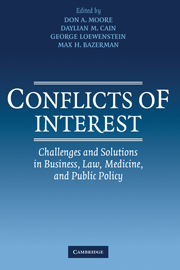Book contents
- Frontmatter
- Contents
- List of Contributors
- Acknowledgments
- Introduction
- PART ONE BUSINESS
- PART TWO MEDICINE
- 9 Physicians' Financial Ties with the Pharmaceutical Industry: A Critical Element of a Formidable Marketing Network
- 10 Commentary: How Did We Get into this Mess?
- 11 Why Are (Some) Conflicts of Interest in Medicine So Uniquely Vexing?
- 12 Commentary: Financial Conflicts of Interest and the Identity of Academic Medicine
- PART THREE LAW
- PART FOUR PUBLIC POLICY
- Index
- References
10 - Commentary: How Did We Get into this Mess?
Published online by Cambridge University Press: 04 August 2010
- Frontmatter
- Contents
- List of Contributors
- Acknowledgments
- Introduction
- PART ONE BUSINESS
- PART TWO MEDICINE
- 9 Physicians' Financial Ties with the Pharmaceutical Industry: A Critical Element of a Formidable Marketing Network
- 10 Commentary: How Did We Get into this Mess?
- 11 Why Are (Some) Conflicts of Interest in Medicine So Uniquely Vexing?
- 12 Commentary: Financial Conflicts of Interest and the Identity of Academic Medicine
- PART THREE LAW
- PART FOUR PUBLIC POLICY
- Index
- References
Summary
I have been aware of the close ties between physicians and the pharmaceutical industry since the day I began medical school in 1984 and received a free stethoscope from a kind-hearted pharmaceutical company. Later that year, I received an expensive medical school textbook from another company, and, over the next several years, I ate more than a few donuts provided by sales representatives who set up meeting areas within the hospital at which I was training. When I left medical school and began residency training, I began to realize that some people thought it was inappropriate for doctors to get too cozy with the pharmaceutical industry. The Mayo Clinic, where I trained, banned pharmaceutical representatives from its grounds, to reduce industry influence on its physicians. In response to this policy, pharmaceutical representatives from several companies got together and rented a large hall in a hotel across the street from the clinic, where they provided food and conversation to Mayo Clinic physicians every week; we all, staff and trainees alike, gladly trudged across the cold Minnesota streets to receive free food and copies of important research articles that the sales representatives thought we should know about.
It is safe to say, then, that I have been aware of the close ties between physicians and industry for a long time. But until reading Dr. Kassirer's disturbing summary, I was unaware of the thoroughness of the pharmaceutical marketing network.
- Type
- Chapter
- Information
- Conflicts of InterestChallenges and Solutions in Business, Law, Medicine, and Public Policy, pp. 142 - 151Publisher: Cambridge University PressPrint publication year: 2005
References
- 2
- Cited by

